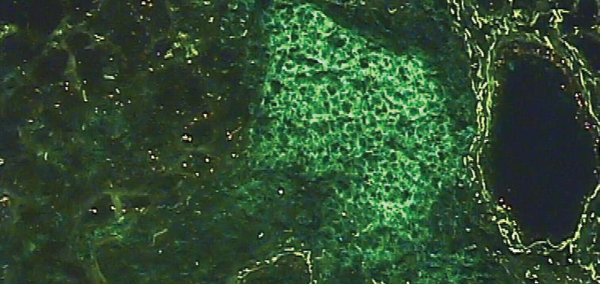
Photomicrograph of the salivary gland of a person with Sjögren’s syndrome, characterized by the abnormal migration of of lymphocytes T and B. Here only the lymphocytes B appear in green.
UEB IFR140 / ScienceSource.com
“We anticipate the guidelines will be used as an evidence- and expert-based reference to identify useful therapeutic pathways for highly relevant clinical questions,” Dr. Carsons says. “Due to the varied clinical presentation of Sjögren’s, we emphasize an individualized patient-centered approach.”
The committee endeavored to consider the context of rheumatology practice in formulating the guidelines to give practitioners “as many therapeutic options as possible while providing some guidance and clarity,” he says. “In other words, we really tried to not shut the door to therapies that some rheumatologists have found beneficial in their experience. On the other hand, the strength of our recommendations is strongly influenced by the quality of available evidence.”
Use of Biologic Therapies
The guidelines include a strong recommendation that tumor necrosis factor (TNF) inhibitors not be used to treat sicca symptoms in patients with primary Sjögren’s syndrome. The recommendation was based on one small controlled trial and a multicenter randomized controlled trial. The committee recommends that patients with primary Sjögren’s syndrome be monitored for toxicities if TNF inhibition therapy is being used for rheumatoid arthritis or other related and/or overlapping conditions.
The recommendation against TNF inhibitor therapy may be surprising, due to the comfort of rheumatologists with TNF inhibitors in multiple subtypes of autoimmune rheumatic diseases and a tendency to try them in related disorders when other therapies fail, Dr. Carsons explains. “However, because of the strength of the data from controlled trials in that area, we felt comfortable making that statement.”
Although TNF inhibitors are not recommended for treatment of glandular manifestations of Sjögren’s (xerophthalmia and xerostomia), their use is recommended should another rheumatic disease for which they are indicated be present, such as RA overlap or psoriasis, Dr. Carson says.
Another biologic agent, rituximab, may be considered a therapeutic option for keratoconjunctivitis sicca in patients with primary Sjögren’s syndrome, and it also may be considered for patients with xerostomia when there is evidence of residual salivary production and significant evidence of oral damage after conventional therapies have proved insufficient.
The guideline includes a strong recommendation that tumor necrosis factor (TNF) inhibitors not be used to treat sicca symptoms in patients with primary Sjögren’s syndrome. … Their use is recommended should another rheumatic disease for which they are indicated be present, such as RA overlap or psoriasis. —Dr. Carson
“The decision to use a biologic agent, such as rituximab, to treat dry eyes and/or dry mouth would be appropriate only in severe cases and with necessary input from the patient’s ocular and/or oral medicine specialist,” the guidelines state.

